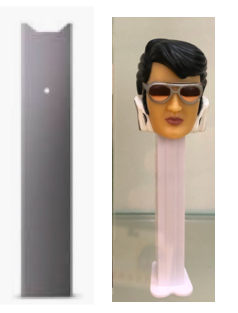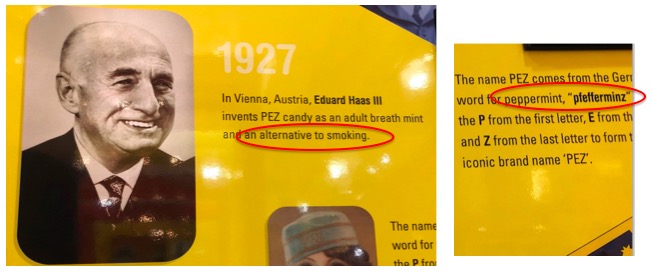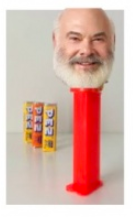
Time for a riddle:
Q: What is the difference between Pez and Juul?
A: Not much. Both companies sell products intended to help people stop smoking, and both use fruit flavors to market them to children. (1)
But there are a couple of differences as well. One dispenses a liquid and the other, a solid. One substance is highly addictive and the other not.
And the devices that hold the products look a bit different:

(Left) Juul e-cigarette. (Right) Elvis Pezzley Presely Pez Dispenser.
If you're on Interstate 95 in the vicinity of Orange, CT you might see a sign which might make you think you're tripping rather than on a road trip.

The Road To Pez! I-95, Orange, CT
You're not tripping. It's real. I was here yesterday.

(Left) Some idiot at the Pez Visitor Center. (R) Upon entrance, you are greeted by 793 different dispensers.
Why Pez?
If you're wondering why it makes sense to include Juul and Pez in the same article, it actually does, and more than you'd think. Who could have possibly known that during this time of turmoil in the vaping universe that I had stumbled upon the world's first smoking cessation product: Pez. I kid you not.

Edward Haas III, inventor of Pez (1927)
Pez, which is an acronym for pfefferminz, German for peppermint, was invented in Austria in 1927 by Edward Haas III, who was fiddling around (2) with a type of baking powder and peppermint oil. Haas came up with a mint that he decided to market as an alternative to smoking. In this way Haas was way ahead of his time; cigarettes were thought to be good for you back then. No matter the reasons that people wanted to quit, when they turned to Pez neither the product nor its dispenser it looked anything like it does today:

(Left) Original Pez (1927) was a round mint. (Center) In 1942 it was still a round candy with only one flavor but came in a cool looking tin. (Right) Modern fruit-flavored bricks.
The candy, which tastes just as good (bad?) as it did when you were a kid, is nothing special. It is the dispenser that sells billions of Pez candies every year in 90 different countries.

(Left) The first Pez dispenser was introduced at the 1949 Vienna World's Fair. (Center) The drawing that Oscar Uxa, the inventor of the Pez dispenser, used to get it patented in 1952. Talk about changing the world. (Right) Santa Claus Pez (1955) is the most popular dispenser.
Does it work?
I could find no evidence that peppermint is useful to help stop smoking, but the role of sugar is interesting. Glucose tablets have been shown to reduce the craving for cigarettes, and nicotine also reduces the craving for sugar. Smokers are more likely to become diabetic, but people who quit smoking are also more likely to develop diabetes due to weight gain.
Extra Bonus
ACSH is a frequent critic of woo, and where there's woo there's Weil. As luck would have it, more than two years ago, for no particular reason Dr. Weil got turned into this:

Dr. Andrew "Pezhead" Weil (See It's World Homeopathy Week! All 8 Days Of It)
Perhaps it's time to update things...

Dr. Andrew "Vapehead" Weil
But in the interest of fairness, it would be wrong not to include this...

Even though I know with absolute certainty that I will live to regret this.
Could be worse. At least I'm not selling nicotine to kids.
NOTES:
(1) The FDA just sent a warning letter Juul about marketing to minors. The company is in all kinds of hot vapor.
(2) If you're wondering how Edward Haas III had the time to fiddle around was that Edward Haas II a wealthy businessman.



